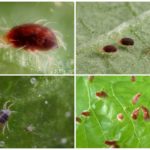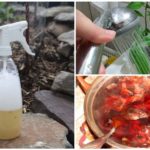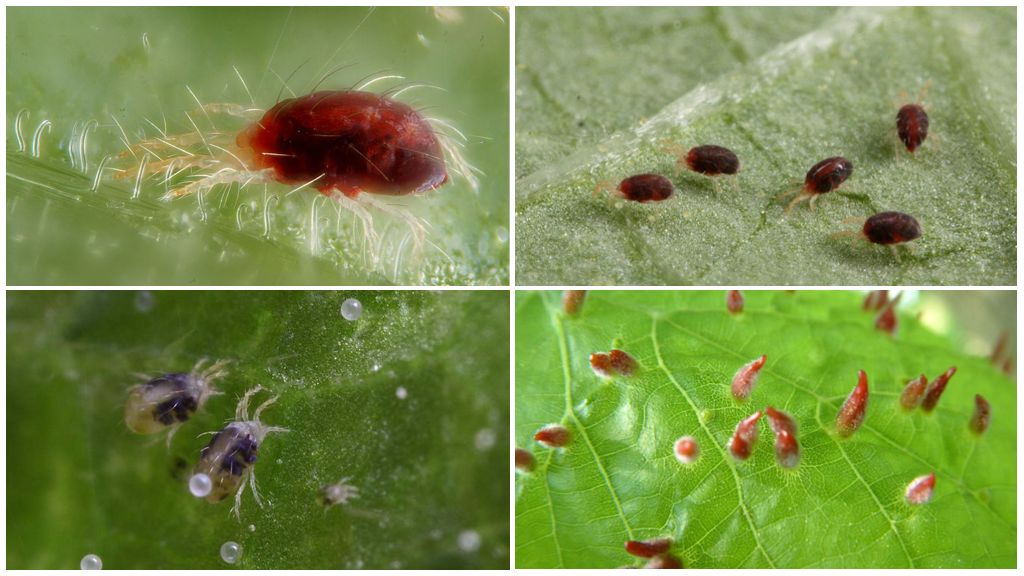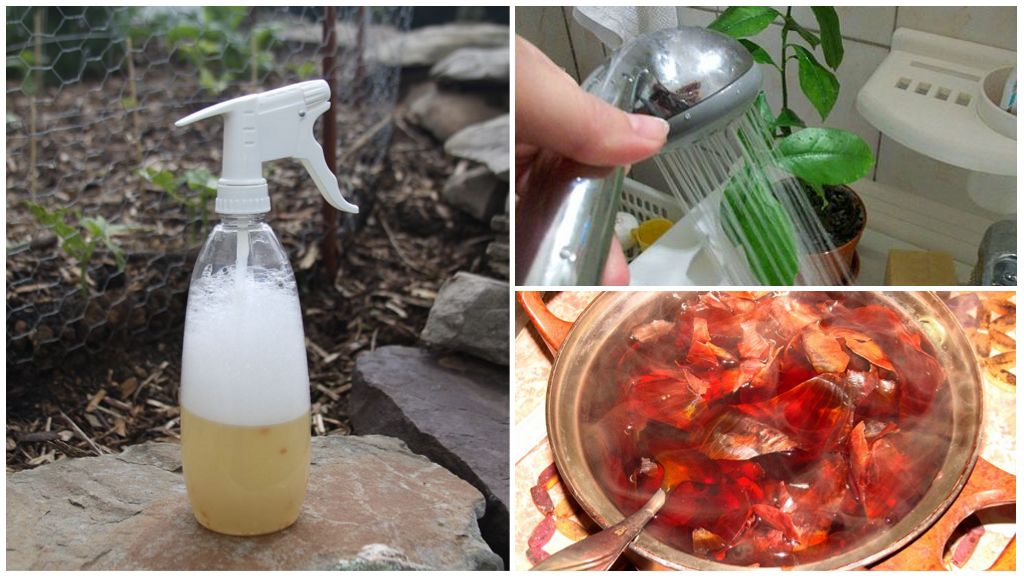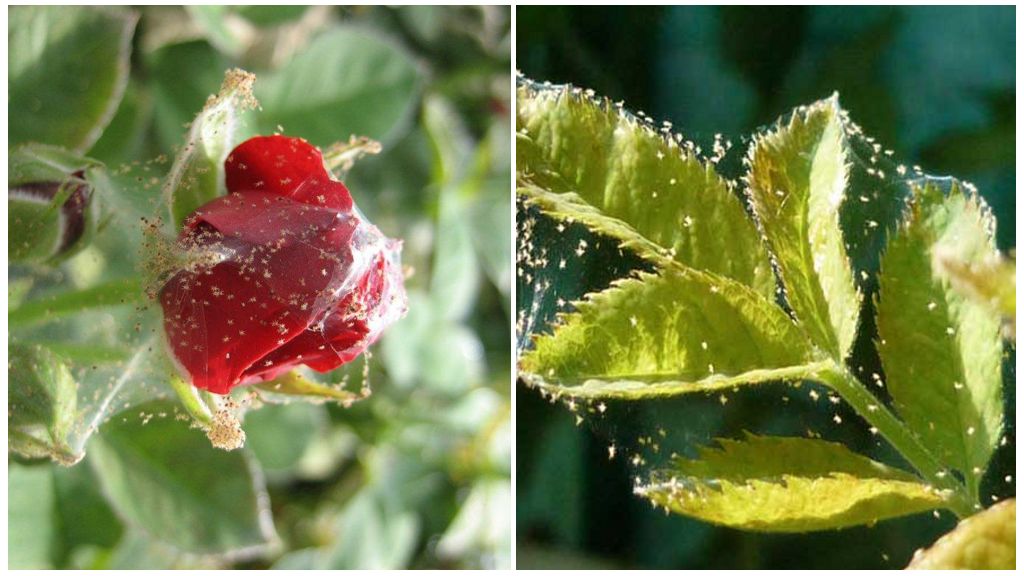Description and photo spider mite
Content
- Spider mite and its larvae
- Pest control methods
- Insecticides to combat spider mites
- Spiderweed plants
Spider mite can be found everywhere: on vegetable crops in the garden, on fruit trees, bushes in the garden, and even on indoor plants. The family of this pest has more than a thousand species distributed on all continents except the South and North Poles. The spider mite has received such wide distribution due to its small size, good fecundity and omnivorous.
What does a spider mite look like?
Almost every gardener and gardener is familiar with the appearance of a spider mite. He is a representative of arachnids and is very similar to a small spider. The body has an oval shape with a length of 0.3 to 0.8 mm. Females can be almost twice the size of males. The tick has four pairs of limbs, at the ends of which are located sharp hooks, with the help of which it cleverly moves over the leaves of the plant.
The larvae are small spiders of pale green or brown flowers with 6 limbs. Adults have a bright orange or red color.
On a note!
Egg laying looks like translucent round-shaped beads of a yellowish shade scattered on the underside of a leaf.
Photos of spider mites and its larvae are presented below.
Spider mite can be of several types:
- the red spider mite mainly lives on flowers: roses, callas, orchids, cinerarias;
- cyclamen - prefers cyclamens, balsamines, chrysanthemums;
- a wide spider mite infects cacti, oleander, citrus leaves, rubber plants;
- bulbous root mite - strikes plant bulbs under the ground, gnawing the middle and turning it into dust;
- Atlantic and Pacific - the closest relatives of the common mite, live in warm and humid regions and feed on citrus leaves and palm trees;
- flat orange mite or flatrope is often found on the leaves of violets.
Harm to mites for plants
The common spider mite got its name thanks to the weaving of a fine web from the inside of the leaf, where it is most often located. The tick is considered to be a pest because of its food preference - it sucks the sap from the plants, after which the leaves turn yellow and dry. When a parasite destroys a large number of leaves of a plant, the process of photosynthesis is disturbed, which entails a decrease in yield and even death of the culture.
The first signs of a spider mite that can be seen with the naked eye are the appearance of yellow and brown spots on the leaves. In these places, the parasites suck the sap of the plant. Also on the back of the sheet visible thin film of white web. If you look closely, you can see the red or orange dots moving erratically, - this is the spider mite.
On a note!
Many beginning gardeners at the sight of affected vegetable tops of vegetables may think: is a tick dangerous to humans? There is no threat to human health from these small creatures.
Garden and garden parasites are very prolific. Under favorable conditions, one female can lay more than a hundred eggs in her short life of 30 days. After 2-3 days, voracious larvae appear from them, and after 2 weeks, no less voracious adults. When their numbers increase to several hundred thousand, the plant on which they live has a hard time.
The affected leaves of room or garden crops cannot synthesize sunlight, and gradually the plant weakens and becomes vulnerable to diseases and viruses. If you do not notice the symptoms of infection in time and do not begin to fight the plant mite, the representative of the flora dies.
Pest control methods
When a parasitic spider is found on a vegetable or flower crop, you can use folk remedies to get rid of it. Among the most popular ways there are several:
- The easiest method is spraying with ice water. This option is suitable for saving roses.
- Well helps against spider mite treatment with infusion onion peel. It is necessary to fill with one liter of water a handful of husk, tightly cover and wait 6-7 hours. The resulting liquid is sprinkled on the affected leaves.
- Infusion on garlic is a versatile remedy against garden mites. His recipe is simple: 150-200 grams of finely chopped garlic is infused in one liter of water in a closed container for 5 days. The resulting concentrate in the amount of 6-10 grams is diluted in a liter of water. The working solution is used for spraying the foliage.
- The soap solution is suitable for the treatment of both indoor flowers and vegetable crops. To do this, 50 grams of soap tinder grated and dissolved in a liter of water. Soap medicine is sprayed onto the plant.
- Alcohol can be a good way to protect a plant from a flower tick. It is necessary to apply a few drops of alcohol to a cotton swab and wipe each leaf of the flower with it. Abundant use of alcohol can cause burns on delicate leaves.
- To destroy the spider mite, you can purchase its natural enemy of the predatory phytoseylus mite. It multiplies rapidly and will help in a short time to get rid of parasites at all stages of development. And when the food ends, the predator will die.
When the infection with a spider pest turned into a large-scale disease, it is necessary to move to radical methods.Chemical insecticidal and acaricidal drugs can save the plant even when it is almost completely exposed to this scourge. Among them are very popular:
- Karbofos is an organophosphorus agent based on the active ingredient malathion. It has a detrimental effect on the parasites and, if it comes into contact with them, causes paralysis and poisoning. The treatment of the tops of garden crops should take place in windless dry weather early in the morning. Protective effect lasts for 7-10 days.
- Apollo is an effective acaricide, which is aimed at poisoning eggs and tick larvae. An adult individual, by direct contact with a chemical preparation, ceases to be capable of reproduction.
- Fitoverm is a biological insecticide. It can be used for indoor plants without the fear of chemical poisoning. The ampoule with the drug is diluted in water and sprayed with foliage. Protective effect lasts up to three weeks.
- Sticks Plant-Pin - a new way to protect the flora from the effects of ticks. The sticks are impregnated with the active ingredient butoxycarboxyme. They are stuck in a pot around the perimeter of the stem of the plant. The number of sticks depends on the diameter of the pot.The larger it is, the greater the number of sticks to be inserted into the pot. When watering, water dissolves the insecticide and permeates the roots. The plant becomes invulnerable to parasites for 2 months.
Prevention of plant pests
To prevent the occurrence of a spider pest, it is necessary to eliminate any possibility of infecting plants with it. To do this, you need to know where the spider mite comes from. He can crawl from a nearby plant, fly with a gust of wind, accidentally be brought from the street. To prevent these accidents from happening, you need to follow certain rules:
- check for the presence of pests every plant at least once a week;
- not to place a new flower brought from outside next to flower crops until it passes a two-week quarantine period;
- not to bring cut flowers on the street into the house and not to put them on the window sill;
- more often carry out wet cleaning of the room, wash windows, window sill, frames, wash curtains;
- more often spray the foliage of plants with plain water or soapy water;
- as a preventive measure, lower the temperature in a room with flowers, ventilate the room;
- clean up the garden and garden fallen leaves, grass, tops;
- destroy weeds in the garden;
- garbage or marigolds can be planted next to vegetable crops to repel pests;
- when buying flower land in a store or taking it on the street, you need to ignite it in a microwave oven or in an oven;
- when a tick is found on one of the indoor plants, it is necessary to remove it away from other plants.
All these simple measures will reduce the risk of infection with a dangerous parasite. The main thing is to be attentive to your favorite plants and to have in stock several ways to save them from spider mites.

